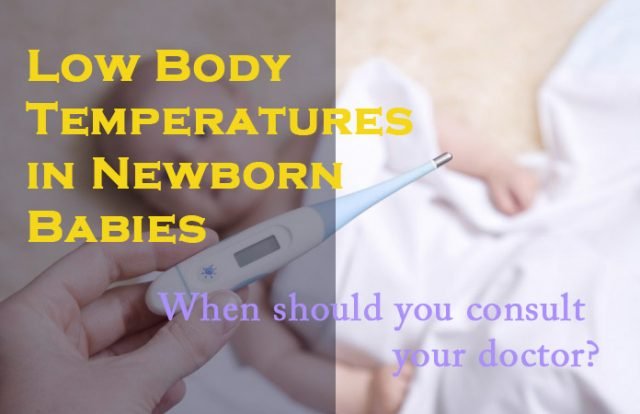Humans are warm blooded animals, with awesome power of homeostasis, which is the capability of the body to adapt its temperature to suit the outside conditions. While adults adapt pretty well under normal circumstances even when there are sudden changes, children, especially babies, may find it difficult. This chiefly owes to underdeveloped power of immunity, and immature body mechanisms. While fever/hypothermia (high temperature conditions) is pretty common in babies, a low temperature condition, or hypoxia, is not much talked about.
Note that hypothermia is mostly indicative of quite serious internal conditions, unlike common fevers. So it is very important to know the cause of hypothermia right at the beginning to bring about effective treatment. Consulting a physician is the first step in treating hypothermia. Here is all that you need to know in order to be prepared for reduced temperature conditions in your infant.
When should you consult your doctor?
According to the American Academy of Pediatrics, the normal body temperature for infants up to 3 months of age is 97 to 100.4 degrees Fahrenheit, or 36 to 38 degrees Celsius. Temperatures more or less than this should mean an immediate consultation with a doctor.
- Any of the conditions listed below are enough to warrant an immediate consultation with your doctor. The temperature of a baby fluctuates with conditions like hunger, acidity, excitement, or some other ailment. However, body temperature below 36 C or 90F should not be overlooked at any cost as it can lead to very serious conditions, including organ failures.
- If your child often runs low temperature, especially in the range of 90 to 95F, the physician should consider thorough, probably long term treatment.
- Remember that low temperatures are often indicative of other, bigger problems. So even if your child’s temperature drops only during fevers or diarrhea, don’t neglect it. Instead of thinking it as something that would soon be okay, develop some emergency plans for possible situations.
- In case your baby has otherwise regular temperatures but gets a sudden drop, run to the doctor immediately.
Measuring body temperature in infants:
When measuring the temperature of an infant, it is best not to use the old-fashioned mercury glass thermometers. In case of damage, there would be glass shards AND mercury vapors which may release into the air or mercury balls which may be consumed by the baby. Remember, mercury exposure even at the skin level is harmful.
Today, a wide range of options are available for parents. There is the forehead and ear thermometer, the pacifier thermometer, and the digital thermometer. Mayo Clinic suggests using a digital thermometer to measure the rectal temperature as the most accurate way of recording temperatures of a baby. Place your infant on a comfortable surface and lift her legs. If your infant is less than 3 months, take care to lubricate the tip of the thermometer before inserting it 0.5 to 1 inch inside her rectum. Stop immediately if you feel any resistance. Hold it steadily, without causing her discomfort; till the thermometer signals that it is done.
Low body temperature causes:
1. Cold environment
As a baby’s immunity power is very weak, minor changes in the environment can cause a low body temperature. It then becomes a cycle, as a low body temperature means ideal conditions for viral and bacterial attacks, which in turn can further lower the temperature. So it is extremely important to aid your baby’s natural fighting capabilities by keeping her warm. And it is very easy to do so. Unless the temperature is too high as to be uncomfortable for your baby, make her wear an extra layer of clothing. Ensure low moisture content in the area she inhabits. Wrap a blanket around her, especially when she is sleeping and her defenses are down. Be very careful about bedwetting. Change her clothes and sheets immediately when that happens.
2. Infections
Babies and toddlers have low natural immunity. So it is very easy for them to contract infections due to even the smallest exposures. And at times infections can lead to low body temperatures in babies, thus forming a circle. Most such infections are caused by bacteria on lungs, blood, urinary system and cerebrospinal fluids. Babies who have had premature births or are born to mothers lacking prenatal care are at increased risk of contracting such infections. To determine whether the low core body temperature is the result of an infection or not, check for other accompanying symptoms like low energy level leading to low activity rates, decreased consumption of food, increased sleeping, and irritability. These symptoms alone are more than enough to warrant a medical checkup.
3. Deficiencies
In children, especially in babies, symptoms get magnified. So, their body temperatures decrease every time they are hungry. However, a sustained drop in temperature is never a good sign as it can be indicative of deficiencies like iodine, iron and other such essential nutrients. Once the temperature starts remaining low for a day or two, immediately consult a doctor. It can also operate the other way, as malnutrition itself can lead to low body temperatures, as low fat content and muscle mass decreases metabolism. Sometimes, the cause of malnutrition is not so obvious and can result from psychological factors. Malnutrition can also result from the baby having difficulty consuming food due to reasons like severe heart disease, facial malformations, problems in digestion, enzyme deficiencies, and malabsorption due to cystic fibrosis.
4. Neurological issues
Body temperature regulation is actually a very complex process involving heat receptors in the skin, nerves, and the hypothalamus in the brain which is the center for temperature regulation among other components. Improper functioning of any of these can affect the temperature regulation in the body.
Delivery using vacuum cleaners or forceps should be avoided at all costs, even if it is a premature or difficult delivery. These risk internal brain injuries and bleeding, resulting in a permanent impairment of body temperature conditions in addition to other serious problems. These risks are fortunately rare in full term babies, who however maybe affected similarly by other traumatic head injuries.
Another way in which temperature regulation is affected right at the centre is tumors. Tumors in the region of the hypothalamus or the pituitary gland can negatively affect proper temperature regulation.
5. Metabolic and endocrine diseases
The adrenal, thyroid and the pituitary glands are the ones playing the most important roles in temperature regulation of the body, and any deformity in them can adversely affect that function, in addition to causing other serious problems. Improper functioning of any of these glands affects the metabolism, meaning that not only is body temperature affected, but also growth rates.
Also, sugar plays a very important role in maintaining body temperatures. So, there should be optimum breakdown and utilization of sugar. This is why diabetics have problems with temperature regulation.
Signs:
Different levels of hypothermia produce different symptoms.
Mild hypothermia:
- The baby’s body doesn’t accept normal amounts of food.
- Cold to touch
- Reddening of skin or mild discoloration
- Random weak cries, which could be due to decreased energy and supply of oxygen
- Low energy level due to low metabolism.
- Heart arrhythmias: This is a condition in which the rate of heart beat is too fast, too slow, or irregular.
- Lethargy, due to low energy levels
- It can easily take a turn for the worse and there may be episodes of absence of breathing, requiring external support.
- Hypoxia: As the lungs are the last organs to develop in a fetus, premature babies often end up with hypoxia. This is a pathological condition in which a part or whole of the body is derived of oxygen, leading to rapid fall in temperatures and the skin becoming bluish in colour. Babies with hypoxia are placed in incubators capable of providing continuous positive airway pressure.
- Dizziness and shivering
- Increased rate of breathing due to decreased oxygen utilization
- Peripheral vasoconstriction: In this condition, there is a narrowing of blood vessels due to the contractions of the muscular walls of the vessels. This can be because of many reasons, including reduced oxygen supply, and lowering of temperatures both inside and outside the body. This process helps in heat conservation, and thus is a reflex mechanism in dealing with cold conditions.
Common symptoms of moderate hypothermia are:
- Violent, uncontrolled shivering
- Slurring of speech, or in the case of babies, difficulties in producing sounds
- Difficulty in moving
Severe hypothermia
- Weight loss
- Decreased activity
- Dilation of pupils
- Loss of consciousness
- Shivering doesn’t occur usually
- The ECG reading maybe abnormal due to weak or irregular pulse
- Heart rate is below 60
- Extremely faint pulse which may be difficult to detect at times
Treatment
- Remove wet clothing from around the baby
- Use a room heater and keep the temperature at least 25 degrees
- Give the baby a warm drink if her age is more than 6 months
- Wrap the newborn with warm blankets
- Hot packs or chemical heating pads can be used on sensitive areas like the chest, neck or back..
Prevention
‘Warm Chain’ is a set of interlinked procedures recommended by the WHO which are to be started before birth and continued for as long as the doctor sees fit. They are as follows:
- The temperature in the delivery room should be more than 25°
- Resuscitation processes should not involve exposure to cold
- The baby should be dried immediately after delivery
- The baby and the mother should have as much skin-to-skin contact as possible. The mother has a much higher temperature as compared to the baby, especially soon after delivery. This is known as the Kangaroo Method and in this the baby is placed over the mother’s chest inside her clothing where she is fed every two hours.
- Breastfeeding should be regular and at the proper intervals
- Bathing and weighing of the newborn should be postponed. The baby should not be bathed right after birth. A normal baby should be bathed every second day during summers. In winter, the time gap between two births should be increased. At the same time, it is important to maintain a proper hygiene.
- Proper clothing and bedding
- The mother and the baby should be together as long as possible
- Warm transportation must be ensured. Always make sure that the baby is stable before beginning travel. Consult your doctor and keep appropriate first aid kit ready. Remember that this kit would be different from that required by an adult.
- Try to go for neonatal health care providers who are trained in dealing with situations related to low temperatures in infants.
How to treat low body temperatures in infants?
It may be that your child has a lower body temperature than normal without suffering from any adverse condition. While this can tamper with her immunity, it is something you need to accept. Of course consult a doctor to determine this. But in the long term, there maybe nothing to do here than to ensure that your child is not inconvenienced or uncomfortable at any point of time.
Follow the advice of the doctors minutely. Take care of the little things. When she sleeps, make sure that she is warm in a warm and dry room. You can even keep hot water bottles or warm packs with her. Give her warm baths and warm food. However, take care that the warming is not sudden, as it can adversely affect her health.
Precautions
To prevent untoward incidents, it is very important to take note of certain points
- Monitor your baby’s temperature regularly, preferably every three hours, especially during the first few months.
- While it is justified to be concerned about hypothermia, or when the temperature of your baby is naturally lower than the average, it is very easy to cause overheating. Too much of heat risks Sudden Infant Death Syndrome (SIDS). Proper ventilation of the room where the baby is kept, a fan and just the right amount of bedding and clothing can reduce the risk of SIDS by around 70 percent. You should talk to a pediatrician about the correct way to handle your baby.
- Never medicate without consulting your doctor. Even the most common drugs can be extremely dangerous for your baby. For example, aspirin can cause Reye’s Syndrome, a potentially fatal disorder. Also, babies under 6 months should not be administered ibuprofen.
So keeping these things in mind enjoy your little bundle of joy. It may be hard at times, but remember that a little extra care can go a long way in ensuring a comfortable life for your baby.

































